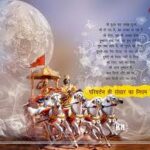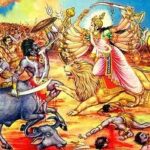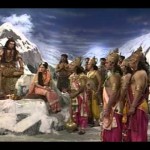न तो भगवान राम . न शिव , न कृष्ण , न ही दुर्गा अहिंसा के पुजारी थे .आधुनिक युग मैं न विवेकानंद, न ही अरविन्द ,न  ही दयानंद सरस्वती अहिंसा के पुजारी थे. इन सब ने तो अन्याय से सतत संघर्ष को धर्म माना था . हमारे भगवानों ने बार बार धर्म की रक्षा मैं युद्ध किया था. तो फिर अहिंसा परमो धर्मा हिन्दू धर्म का मूल मन्त्र कैसे हो सकता है. आज के युग मैं तो हिन्दू धर्म का अस्तित्व ही खतरे मैं है . ऐसे मैं हमारे स्वामियों का अहिंसा का प्रचार हमारे अस्तित्व के लिए ख़तरा बन सकता है.
ही दयानंद सरस्वती अहिंसा के पुजारी थे. इन सब ने तो अन्याय से सतत संघर्ष को धर्म माना था . हमारे भगवानों ने बार बार धर्म की रक्षा मैं युद्ध किया था. तो फिर अहिंसा परमो धर्मा हिन्दू धर्म का मूल मन्त्र कैसे हो सकता है. आज के युग मैं तो हिन्दू धर्म का अस्तित्व ही खतरे मैं है . ऐसे मैं हमारे स्वामियों का अहिंसा का प्रचार हमारे अस्तित्व के लिए ख़तरा बन सकता है.
श्री राम कुमार ओहरी ने इस प्रशन को फिर उठाया है जिका उत्तर देना समाज के लिए आवश्यक है.
Damage Caused By Fallacious Preachings of Hindu Swamis
– Ram Kumar Ohri, IPS (Retd)
– – – – – – –
Though a belief in “Ahimsa” has been an integral part of our civilizational ethos, in post independence years it has assumed the shape of a vainglorious dogma. Mindless and incessant propagation of pacifism by self-seeking politicians has injected massive doses of maldroit passivity into the Hindu psyche. A seriously flawed perception has been drilled into the minds of younger generations by misinforming them that India was able to get independence from colonial rule solely due to the ‘Gandhian magic mantra’ of non-violence, and that ‘Ahimsa’ alone was responsible for forcing the British to quit. Nothing could be farther from truth.
Unfortunately the entire freedom struggle has been dressed up and sold to young Indians as an exclusive non-violent Gandhian miracle, by sidelining the gallant sacrifices of thousands of non-Gandhians. The myth of non-violence has been made supreme history, in a bid to paint it as success story of Indian National Congress. Nothing could be farthest from truth. If Ahimsa was indeed such a powerful weapon, how come that despite paying obeseiance on all fours to the doctrine of Panchsheel and singing aloud the pacifist tune of Hindi-Chini Bhai Bhai, we could not ward off the disgraceful defeat at the hands of Chinese army in 1962 ?  .
.
The heroic history of our freedom struggle is a long and tortuous one in which thousands of freedom fighters, including the famous revolutionaries of Bengal like Master Surya Sen of Chittagong Armoury case, Kalpana Dutt, Ras Behari Bose, Aurobindo Ghosh and Subhash Chandra Bose had played stellar role. None of them was a dogmatic believer in non-violence. Their abiding commitment was to the philosophy of Gita which preached victory through valour over the forces of evil. Similarly no one dare ignore the sufferings and sacrifices made in the cause of freedom by stalwarts like Chandrasekhar Azad, Veer Savarkar and his brothers, Shaheed Bhagat Singh, and the gutsy soldiers of Indian National Army organized by Netaji Subhash Bose. Countrywide hundreds of freedom fighters took up arms to fight the British and opted to kiss gallows, while several thousands spent the prime of their youth in dark dungeons of the Cellular Jail in Andamans, the Fortress Jail of Mandlay in Burma (now Myanmar) and in hundreds of prisons across the country. Let us not forget that not one of them was a votary of non-violence. Many of them aired their disdain for the pacifist dogma boldly and openly, often to the chagrin of even Gandhi Ji. Notable among the warriors of India’s freedom struggle were Bhagat Singh, Batukeshvar Dutt, Veer Savarkar , Subhash Chandra Bose, Ram Prasad Bismal and thousands of braveheart Veers and Veeranganas many of whom kissed gallows smilingly.
In a thought provoking article published in The Economics Times, New Delhi, in August 2007, Swaminathan S. Anklesaria Aiyar, had drawn attention to the fact that in a seminar held in 1967 on the 20th anniversary of independence, Sir John Freeman, the then British High Commissioner in India, had candidly confessed that independence for India became a certainty after the 1946 revolt of the Royal Indian Navy. Even when the British tried to quell the uprising by sending naval boats equipped with gunships to make the rebels surrender, the threat did not work.
The revolt was condemned by Gandhiji, but his sermon had no effect on the rebellious ratings of Royal Indian Navy. Ultimately Sardar Patel was chosen to negotiate with the rebels and he succeeded in convincing the mutineers to opt for peace. Unfortunately most post-modern historians, especially of the Gandhian school, have treated this major event as a minor footnote in the struggle for independence. Truth, however, is that it was this momentous development, more than anything else, which warned the Britishers about the coming storm.
 Conscious of the sheer size of the 2.5 million strong Indian army, commanded by many Sandhurst trained Indian officers, the colonial rulers were quick to realize that if a mutiny broke out in the Indian army, just as it did in the Navy, the uprising of 1857 would look like a small time picnic. Thus, the most important catalyst which made the British quit India was the threat of violence, i.e., “Himsa” and not Gandhian ‘Ahimsa’, concluded Swaminathan Aiyar. And rightly so.
Conscious of the sheer size of the 2.5 million strong Indian army, commanded by many Sandhurst trained Indian officers, the colonial rulers were quick to realize that if a mutiny broke out in the Indian army, just as it did in the Navy, the uprising of 1857 would look like a small time picnic. Thus, the most important catalyst which made the British quit India was the threat of violence, i.e., “Himsa” and not Gandhian ‘Ahimsa’, concluded Swaminathan Aiyar. And rightly so.
It needs to be understood that the “Quit India” movement launched by Gandhiji had petered out nearly five years before the British left the Indian shores. Then what suddenly compelled the British to move out ? When Sir Clement Attlee was asked by the former Chief Justice P.B. Chakrabarty of Calcutta High Court about the reasons which prompted the British Government to grant independence to India, Attlee admitted that the most important reason was the erosion of loyalty to the Crown among personnel of Indian Army and Navy because of the glory of military activism preached by Netaji Subhash Chandra Bose. Upon being questioned about the effect of the agitation led by Gandhiji on the decision of the British to quit India, Sir Atlee’s reply in a wry tone was that it was “minimal”.
In ultimate analysis, the foreboding fear of a rebellion in Indian army and consequential large scale violence became a far more overpowering weapon for winning freedom than the spiel of Gandhian “ahimsa”. Credit, however, must be given to Gandhiji for his immense mobilization of the Indian masses from time to time in the cause of freedom. But by chanting his mantra of ‘ahimsa’ we could not have wrested freedom for India from clutches of the British colonialists.
Similar views were aired by Mr. Fenner Brockway, Political Secretary of the Independent Labour Party of England. According to him, “There were three reasons why India became free. One, the Indian people were determined to gain independence. Two, was the revolt by the Indian Navy. Three, Britain did not want to estrange India, which was a market and source
of foodstuffs for her”.
Another important event which prompted the British to let India go free was the trial of the popular heroes of the Indian National Army (e.g., General Shahnawaz, Col Dhillon and several others) which consolidated the national consciousness and mass fervour thereby strengthening the resolve of Indians to win freedom. Indian National Army was raised by Subhash Chandra Bose during his exile with the avowed aim of freeing India by recourse to weapons. Subhash Bose was a Gita-worshipping warrior at heart and never a believer in non-violence. Albeit he did respect Mahatma Gandhi. Next to the naval mutiny of 1946 was the contribution to freedom struggle made by the arousal of national consciousness during trial of the former leading lights of Indian National Army of Subhash Chandra Bose.
The politically contrived propaganda that India won freedom solely by Gandhian non-violence is actually a cleverly manufactured yarn, foisted on the unsuspecting youngsters by selfish poliiticians. Subsequent events proved that the faulty Gandhian philosophy has been responsible for making Indians shrink back from doing their karmic duty because of the passivity preached by Gandhian intellectuals.
Through relentless propaganda the Gandhians have made the present generation of Indians forget the sacrifices of thousands of valiant freedom fighters who were no believers in ‘Ahimsa’, and yet were as patriotic as Mahatma Gandhi was – and some even more patriotic than Gandhiji.
Dr. Babu Suseelan, a practicing psychologist in America, has vividly described the Hindu psyche thus: “Hindus are unreasonably tolerant, passive and indifferent even in the midst of noxious conditions. They seldom express in full measure the feelings of anger, outrage and expression of aggression. They have become inward looking and indulge in excessive self criticism.” They avoid critical and justifiable aggressive confrontations, or unmask, analyse or express outrage. Instead of offering stout resistance, they keep quiet or talk a lot of “safe” irrelevant nonsense, or act very nice, or show subordinate behaviour to the aggressor. According to Dr. Suseelan this submissive, defensive, behaviour increases the aggressive plan of enemies. Unable to deal with the smouldering frustration, oppression and insult, “Hindus channel their aggression towards each other and indulge in excessive self criticism and irrational tolerance”. This suicidal passive behaviour, shorn of dignity and valour, according to Dr. Suseelan, was responsible for the rank pusillanimity of Hindus. The result was that for centuries “Hindus were under psychological, social and political oppression” by murderous Muslim invaders, Christian colonizer and pseudo-secular fraudsters.
Hindus as Warriors and Worshippers of Arms
History is a witness to the fact that our forefathers were always armed. All our Gods and Goddeses invariably carried weapons which they used for destroying the forces of evil. Shastra-pujan or worshipping of armaments was an integral part of the Hindu tradition. It is time for our youth to rummage through the pages of history and ascertain how did the traditional warriors, and worshippers of ‘shakti’ and ‘shiva’ become irrational believers in the dope called ‘Ahimsa’.
Our scriptures teach us that when ‘ dharma’ is threatened it is mandatory for Hindus to seek the support of weapons to save the innocents, and protect the nation.
Let us not forget that when Rishi Vishwamitra found that it was impossible for him to do his puja and penance due to depredations of wicked Rakshasas, he went to Raja Dashratha and sought the succour of protection by his two warrior sons, Sri Ram and Lakshman, to ward off the evil-doers. The rest is history. In a scintillating article, titled “Dharma Himsa Tathaiva Cha” late Swami Chinmayananda had drawn attention to the fact that the popular saying, “Ahimsa Parmo Dharma” is only a part of the famous Shloka preached in Mahabharata1. [Source: Swami Chinmayananda, “Dharma Himsa Tathaiva Cha” Articles by Swami Chinmayananda,file: ///C:/Documents and Settings/ Who/ My Documents/Downloads/ Gl Haindva Keralam.] The complete shloka is “Ahimsa Parm o Dharma, Dharmah Himsa Tathaiva Cha” which means that non violence is the ideal “dharma”, but equally so is the recourse to violence for protection of Dharma.
It is a pity that Gandhiji emphasized only the first half of the important sacred shloka, lucidly explained by Swami Chinmayananda. No one knows why Gandhiji altogether ignored and disregarded the latter portion which eulogises the recourse to weapons for protection of ‘Dharma’. Swami Chinmayananda is right when he says that this half shloka has moulded our people into a mentality of “quixotic tolerance” of tyranny. He further elucidates that it is the duty of every individual to protect his country, his mother and his wife and children. The misquoted and mis-propagated dogma has made us a nation of cowards who run away from homes at the sight of jihadis, leaving their near and dear ones to be butchered by barbarians. In sheer anger the Swani asks, “When will we learn to fully interpret our Vedas, scriptures and Upanishads?”2 [ibid]
The continuous assaults by invaders on our sacred soil have created a feeling of powerlessness and doubt among Hindu masses. These psychological changes made Hindus ultra tolerant of oppression and insults. According to Dr. Suseelan, these characterological changes, spread by some inadequately read sages and preachers, after advent of Buddhism in the sub-continent, have made Hindus unduly “ tolerant, passive, apathetic and indifferent”.
As analysed by Dr. Suseelan, throughout our blood-soaked history the debilitating injections of ultra pacifism have extracted a heavy price in terms of life, honour and property by emasculating the Hindu society thereby increasing their Fear Quotient (F.Q.) and drastically reducing its Valour Quotient. In post independence decades the Valour Quotient of Indians (read Hindus) has touched a new low so much so that the Hindu masses and leaders don’t react effectively even to the most vile calumny and insults heaped on them and their religious ethos. How come that a society which has a high Intelligence Quotient (I.Q.), a unique Spiritual Quotient (S.Q.) and a superb Knowledge Quotient (K.Q.) has come to acquire an abnormally high Fear Quotient which, along with a fast shrinking Valour Quotient is now threatening its ancient identity of bravery and gallantry.
Is it love for money and yearning for a comfortable life alone which has reduced the Hindu society to such dire straits ? No, there is certainly something more to it. And that something is the gross opiate of passivity and ultra pacifism which has eaten into the vitality of Hindu society.
Let me clarify that anger is bad and so is wanton aggression. But let us not forget that anger is also a gift granted by Lord Shiva to his worshippers. When justice is denied, when insults are heaped on what is held sacred by millions of people, when oppression of the meek becomes order of the day and ‘dharma’ itself is questioned and derided, it is time to get angry. To revive our long lost élan the Hindu society must recall the power of Shiva’s Anger, His Third Eye and above all His “Tandava”.
If Hindu society is to survive in this vicious and violent millennium, a heavy dose of karmic bravery preached by Lord Krishna, laced with Shiva’s anger and Shakti’s energy, will have to be infused into younger generations. The Valour Quotient of the Hindus, especially the youth, must be upgraded and the all pervasive Fear Quotient must be drastically cut out. Promotion of adventure sports, imbibing discipline and military training by joining the N C C and organization of Rifle Clubs can go a long way in eradicating the Fear Factor among Hindus. These will also upgrade their Valour Quotient. Then and then alone will the Hindus be able to counter the vile oppression, widespread injustice and relentless insults being heaped on them by the evil forces of ‘adharma’ and ‘atyachar’.
Frankly, the Hindu leadership has miserably failed to devise a strategy to fight the ongoing jihad. A very troublesome aspect of the problems afflicting the Hindu society is that due to some inexplicable foolishness most Hindus have come to believe that all religions are equal and that every religion preaches peace. But truth is altogether different. It is time to realize the important difference between what is “dharma” and what is “adharma”. The word ‘dharma’, derived from Sanskrit syntax “dhri”, has a sacred connotation, a deep cosmic nuance. It signifies all those actions which are fit to be adopted and followed by the householders, e.g., commitment to truth, kindness towards the oppressed and the weak, performance of one’s duty with dedication, and similar other ‘dharmic’ actions guided by spiritual values. But does every religion says so, or preaches comparable innate
spiritual values? No, definitely not. Can ‘adharmic’ concepts like senseless slaughter of the vanquished and innocent citizens, or plunder of the booty, including carrying away of women and children of the vanquished, be accepted as ‘dharma’? Can imposition of “protection money” by a ruler on his innocent subjects be considered as “dharma” ? Yet without realising the true import of what they are preaching, many Hindu seers, dharamgurus and preachers have been thoughtlessly proclaiming in congregations that all religions are equal. Some have even written books by unwittingly equating the “dharma” with “adharma” by placing all religions on equal footing. All such religious scholars of Hindu Samaj have lost their spiritual moorings. That is the tragedy of Hindu society.
There is an acute dearth of bold, visionary and dynamic leadership in India, especially among the Hindus. It is imperative to encourage and build up a new youthful leadership, imbued with nationalistic zeal and bubbling with daring and dynamism. Time has come to re-read the message of Gita to the slumbering Hindu masses by reminding them of the growing relevance and import of Sri Krishna-Arjuna samvad on the battlefield of Kurukshetra.
The challenge of galloping jihad cannot be met by thoughtlessly harping on non-violence, preached by Gautam Buddha and Mahatma Gandhi. In today’s globally critical situation it is imperative to adopt the path shown by Maryada Purushottam Ram and Karamyogi Sri Krishna.
– – – – – – – – – – – –
References:
1. [Source: Swami Chinmayananda, “Dharma Himsa Tathaiva Cha” Articles by Swami Chinmayananda,file: ///C:/Documents and Settings/ Who/ My Documents/Downloads/ Gl Haindva Keralam.]
2. Ibid.
COPYRIGHT @ Ram Kumar Ohri, IPS (Retd)

5 Responses to “अहिंसा परमो धर्मा ? : Damage Caused By Preachings of Hindu Swamis”